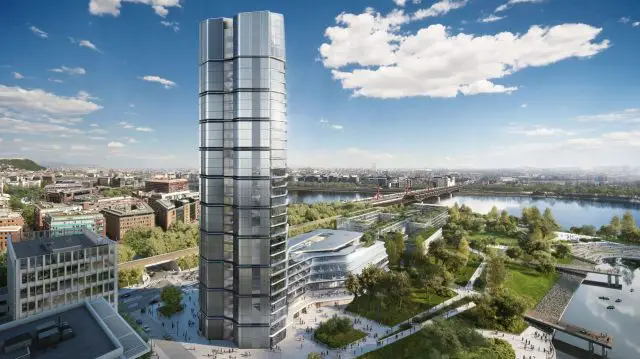MOL Campus is MOL Group’s modern skyscraper and the future headquarters currently under construction in Budapest, Hungary. The 143-meter-high MOL Campus building is realised in the vicinity of Budapest’s popular green oasis, the Kopaszi Dam. The high rise is designed by Foster and Partners and will be the tallest structure in Budapest and in Hungary when completed.
The new view of Budapest.
The shape of the tower has been modified a number of times during the construction so as to make the interior areas transparent and interconnect. The tower will contain spaces linked with a high gallery, a floating staircases and a conservatory to help the internal communication of the organisational units set on different levels. The tower will be a actual, inspiring community area to the employees of the Hungarian multinational oil and gas company, MOL Plc. The tower’s stability is guaranteed despite its extra height. Gergely Baumann, the technical director of the contractor Market Építő Plc, stated that a solid structure certifies the strength of the skyscraper: the twin reinforcing concrete shaft cores serve as the backbone of the structure, with ten concrete circular pillars surrounding. The building’s structure stands on a 2.2-meter-thick base plate on which 4,400 m3 of concrete have been placed. The strong base protects the tower in from an oscillation or earthquake with the measurements done continuous also verifying.
The tower block will consist of 28 levels. On the top, there will be a rooftop terrace with a glazed steel structure raised to a height of 23 meters for wind protection. The terrace will be open from upper side. Furthermore, the skyscraper will offer area for a fitness room, canteen with balcony, restaurant, bicycle storage, hall and a reception space. MOL Campus will also have 21 elevators in the two structures and two fire elevators, which cannot stop even there’s firein the building. The elevators move at a speed of 18 km/h, meaning that they reach at the roof terrace in thirty seconds from the ground floor. The designers revealed that, the building fits into the architectural image of Budapest while offering a new architectural value. Nevertheless, the UNESCO consultants thinks that the structure has a detrimental impact on the architecture of Budapest, which destroys the world heritage panorama of the capital. This can be experienced mainly by walking on the Margaret Bridge, from where the Mol Tower rises high among the domes of the Basilica, the Parliament, Gellért Hill and the Buda Castle World Heritage Sites. However, the construction of the MOL tower complies with all regulations.
Read also:The 9 DeKalb Avenue Tower in Brooklyn project timeline
Timeline

2019.
The 143-meter-high MOL Campus construction started way back in 2019 October and since then, it has posed various architectural, mechanical and design challenges. This is mostly because of the building’s particular shape: it has a double-curved surface, which had to be traced by both the glass and the holding aluminium structure to ensure the connections air and watertight.
2020
The pile base of the entire earthworks and the structure’s building part, as well as the base plate additionally with 4400 cubic meters of concrete, were done by February 2020. Also completed was the leaking layer in the whole excavation pit and the construction works of the high slab and the structure had started. By April to May, the whole construction of the bottom two of the four basement levels had completed on the podium area of the tower, with the -2. above the level, the slab building takes place in several stages.
2021
Even at the halfway point in May, the tower could be seen from almost all parts of the city. By September, the Hungarian oil and gas company MOL had topped out the 120-meter high, 28-floor MOL Campus. The complex is now the tallest tower in Budapest with 165 meters at the highest point. The skyscraper is scheduled to complete by autumn 2022. The project still divides the local population strongly keeping them wondering whether it will beautify or damage Budapest’s panorama?

